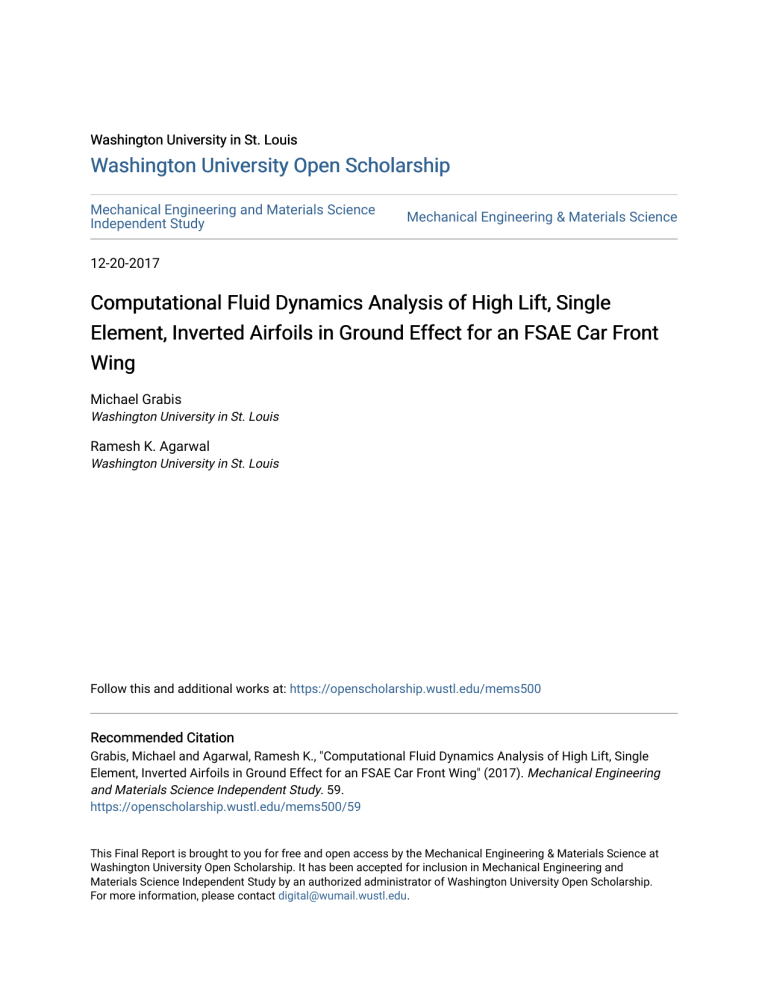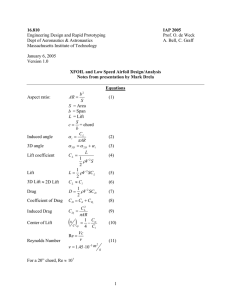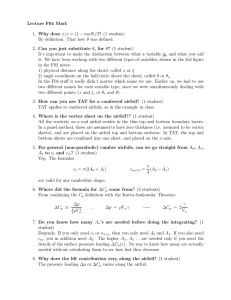CFD Analysis of Airfoils in Ground Effect for FSAE Car
advertisement

Washington University in St. Louis Washington University Open Scholarship Mechanical Engineering and Materials Science Independent Study Mechanical Engineering & Materials Science 12-20-2017 Computational Fluid Dynamics Analysis of High Lift, Single Element, Inverted Airfoils in Ground Effect for an FSAE Car Front Wing Michael Grabis Washington University in St. Louis Ramesh K. Agarwal Washington University in St. Louis Follow this and additional works at: https://openscholarship.wustl.edu/mems500 Recommended Citation Grabis, Michael and Agarwal, Ramesh K., "Computational Fluid Dynamics Analysis of High Lift, Single Element, Inverted Airfoils in Ground Effect for an FSAE Car Front Wing" (2017). Mechanical Engineering and Materials Science Independent Study. 59. https://openscholarship.wustl.edu/mems500/59 This Final Report is brought to you for free and open access by the Mechanical Engineering & Materials Science at Washington University Open Scholarship. It has been accepted for inclusion in Mechanical Engineering and Materials Science Independent Study by an authorized administrator of Washington University Open Scholarship. For more information, please contact digital@wumail.wustl.edu. Computational Fluid Dynamics Analysis of High Lift, Single Element, Inverted Airfoils in Ground Effect for an FSAE Car Front Wing Michael Grabis Washington University in St. Louis Nomenclature a c CD CL h Re = = = = = = angle of attack, between chord line and line parallel to ground chord length drag coefficient lift coefficient height off the ground Reynolds Number I. Introduction Formula SAE is an annual student engineering design competition centered around creating a formula-styled, open wheeled racecar. These cars compete in Formula SAE competitions world-wide and get evaluated on their design in static events as well as their actual performance in dynamic events, the final of which is a 22 km Endurance Race. Competition speeds can be considered low velocity racing; average speeds range from 40 to 48 km/hr [1] while top speeds in a straight-away can reach around 100 to 105 km/hr. Most of the Endurance lap is comprised of slalom sections, while an average course contains at least 3 straight-away sections. Although the racing is mainly at a low velocity, aerodynamics play a large part in vehicular design. Generally speaking, a car body generates positive lift. Positive lift, the force that allows planes to fly, hinders high speed cornering ability due to the force decreasing the mount of traction the tires have with the ground. There are many aerodynamic components such as a front wing, a rear wing, a flat underbody tray, and rear diffusers that can be created to generate negative lift that counters this phenomenon. This study specifically focuses on a front wing to increase negative lift generation at the front of a Formula SAE car’s chassis. The front wing will have a 2D cross section of an inverted airfoil that is located in close proximity to the ground at the front of the vehicle. Airfoils behave much differently in close proximity to the ground than they do in free-stream air; pressure/velocity changes of flowing air due to the ground are called “ground effects”. A primary study will be about the effects of angle of attack, a, conducted on airfoils at a set height of h = 0.106 m that have a chord length of c = 0.33 m. A second study that is discussed is about the airfoil’s height off the ground which is conducted on airfoils at a set angle of attack a = 6o and the same chord length, c = 0.33 m. II. Geometry Front wings on Formula SAE cars are created from extruded airfoil geometries. There are limitations on the size and location of a front mounted aerodynamic device, most notably that it cannot be “further forward than 700 mm forward of the fronts of the front tires” and “when viewed from the front of the vehicle, the part of the front wheels/tires that are more than 250 mm above ground level must be unobstructed”. One must also consider the forward movement of the tire when the wheel is turned therefore no part of the wing could enter the “keep-out-zone defined by…positions 75mm in front of and 75mm behind” [1] the front wheel. These rules set a general constraint on sizing and height of a potential front wing geometry. This study primarily looks to maximize the downforce, or negative lift, that is generated by a single element airfoil in ground effect. Airfoils to be studied were chosen from previously created high-lift airfoils versus creating unique geometries from scratch. The following five high-lift airfoils were examined. o (CH10) Chuch Hollinger CH 10-48-13 o (E423) Eppler E423 o (FX74) Wortmann FX 74-CL5-140 o (LA5055) Liebeck LA5055 o (S1210) Selig S1210 All point data files for each airfoil were sourced from the UIUC Applied Aerodynamics Group Airfoil Coordinates database. [2] Point data files were imported into Microsoft Excel, formatted for ANSYS ICEM import, and imported into the ICEM meshing software directly. III. Grid Generation The airfoil geometries were run in the ANSYS meshing software ICEM for its superior control over creation of a structured grid. Each case run had a constant chord length of c = 0.33 m. Instead of a traditional C-Grid that is normally used for airfoil geometries, a rectangular domain was chosen. The bottom of the domain, directly under the airfoil, is modelled at a height of h away from the lowest point on the airfoil’s lower surface to simulate the ground. The far field outlet was set at 20c rearward from the trailing edge of the airfoil while the far field inlet and far field top were set at 10c forward and above of the leading edge of the airfoil, respectively. Figure 1 shows the entire domain while a detailed view is presented in Figure 2. Figure 1 Figure 2 Entire rectangular domain. Close view of grid around the airfoil geometry. A mesh independence study was created to determine the accuracy of various mesh densities. The benefit of a courser mesh is shorter run times, but there is risk of error in the calculated value. The mesh independence study run was simulated on the CH10 airfoil, a = 0o, h = 0.106 m with three mesh densities spaced apart by 100,000 elements. The results are shown in Table 1. Table 1 Mesh independence study for three mesh densities. Elements 150,000 CD 0.04372 CL -1.11125 250,000 0.04371 -1.11307 350,000 0.04370 -1.1131 It is evident that the values for CD and CL do not vary greatly between the mesh densities. A mesh density of 250,000 was chosen to properly transition from the initial cell spacing dictated by the chosen y+ value of 1. Y+ values are required to properly resolve the boundary layer of any object subject to fluid flow; the value of 1 is determined by the turbulence model discussed in Section IV of this report. IV. Numerical Setup of CFD Solver ANSYS Fluent is the flow solver of choice for running the flow simulation. The 2D airfoil cases were output from ICEM with the proper boundary conditions of velocity for inlet, pressure for outlet, symmetry plane for the top of the domain, and wall conditions for the airfoil as well as the ground. The energy equation was selected on and the k-omega SST turbulence model was chosen for the simulations. The SST model, specifically, gives highly accurate predictions for regions experiencing flow separation and increased accuracy in boundary layer simulations. Due to the lower velocity nature of the race, the low-Re corrections were also selected for the viscous model. Air was set as an ideal gas due to the incompressible approximation of air flow and the viscosity was set to Sutherland. The flow inlet speed was set at 14.5735 m/s (chosen from the average speeds stated in the FSAE rules) and the wall boundary condition was set as a moving wall, mimicking a moving ground, with a velocity of 14.5735 m/s. The Pressure-Velocity Coupling solution method was chosen. It was first iterated with density, momentum, turbulent kinetic energy, specific dissipation rate, as well as energy set to first order upwind for 1000 iterations to improve speed of convergence. Once completed, the aforementioned factors were set to second order upwind and iterated until 10,000 iterations or convergence of all residuals to 1e-5. The first case study was varying angles of attack with a constant height off the ground of h = 0.106 m. Each airfoil was iterated from a of 0o to 15o, as those are reasonable angles for a main element of an FSAE front wing based off of the rule constraints. The second study was a height study to determine how the ground effects an airfoil at low velocities. The three airfoils with the highest CL values from the first study were chosen for the second ground effect study. In this study a = 6o for each run, while h was iterated from 0.0127 m to 0.9144 m with smaller changes in height between runs the closer the airfoil was to the ground (to increase data resolution). V. Numerical Results for 2D Airfoils The Reynolds number for both runs was 295,000, assuming air properties in close proximity to sea level, a reference chord length of 0.33 m, and a desired y+ of 1 for the SST k-omega turbulence model. The initial wall spacing for the boundary layers around the airfoils was set at 2.4e-5 m to adequately calculate the boundary layer’s effect on the airfoil. The primary goal in the first study of angle of attack was to determine which airfoils have the highest CL and at which angles of attack that peak value occurs, when subjected to a ground effect. Figure 3 shows how changes in angle of attack effect the negative lift (downforce) coefficient of each of the five airfoils examined and Figure 4 shows how changes in angle of attack effect the drag coefficient for each airfoil. Negative Lift Coefficient vs. Angle of Attack 2.5 Negative lift coeffcient 2 1.5 CH10 E423 FX74 1 LA5055 S1210 0.5 0 0 3 6 9 12 15 Angle of Attack (degrees) Figure 3 Numerical values for negative lift coefficient at various angles of attack. Drag Coefficient vs. Angle of Attack 0.25 Drag coefficient 0.2 0.15 CH10 E423 FX74 0.1 LA5055 S1210 0.05 0 0 3 6 9 12 15 Angle of Attack (degrees) Figure 4 Numerical values for drag coefficient at various angles of attack. There is a much larger spread of lift coefficients than there is for drag coefficients. The CH10, E423, FX74, and S1210 airfoils all have relatively high negative lift coefficients between 3o and 9o. It is difficult to directly compare the drag to the negative lift coefficients so therefore Figure 5 introduces a plot of the airfoil efficiencies to determine which airfoils are most aerodynamically efficient (CL/CD). Drag is not a large factor at average Formula SAE speeds (14.5735 m/s) so therefore negative lift generation has a much larger weight in airfoil selection, though, it is still useful to observe overall airfoil efficiency in this selection. Efficiency (L/D) vs. Angle of Attack 60 50 Efficiency (L/D) 40 CH10 E423 30 FX74 LA5055 20 S1210 10 0 0 3 6 9 12 15 Angle of Attack (degrees) Figure 5 Numerical values for efficiency at various angles of attack. When efficiency is considered, amongst lift and drag generation, it is evident that the S1210 airfoil is superior for a main element of a Formula SAE car front wing. It generates the highest amount of negative lift as well as has the highest efficiency for nearly every angle of attack that was tested. Figure 6 shows a velocity magnitude contour for the S1210 airfoil at a = 6o and 15o to quantify air behavior between two distinct changes in angle of attack to help examine why the changes in both coefficients occur. Figure 6 S1210, a = 6o (top) a = 15o (bottom), velocity contour plot. The areas of high velocity in Fig. 6 are highlighted in colors ranging from yellow to red, free-stream air velocity is green, while lowest velocity regions are colored from light to dark blue. The negative lift generation peaks between a = 6o and 9o and then begins to drop. The larger area of dark blue in the bottom image shows the increased flow separation off of the airfoil at higher angles of attack. The air here is essentially at 0 m/s and therefore is stalling. Observing Bernoulli’s principle, as velocity increases then pressure decreases (and vice versa) so the greater velocity region seen in the top image creates a larger, lower-pressure area on the bottom surface of the airfoil, contributing to an increased amount of lift generation. The flow separation impedes the airfoil’s ability to create a low-pressure region so as we can see in the data in Figures 3 and 4, negative lift generation decreases steadily while the amount of resultant generated increases at a strong, positive exponential rate (R2 =0.997). After the S1210, the FX74 and E423 airfoils are the next two most efficient airfoils; these three airfoils are selected for the second height study. The height study will be very useful to ultimately examine how ground effect plays a role in Formula SAE race car aerodynamics. To isolate these effects, a constant a = 6o is used and the airfoils are all run at the same speeds with the same chord lengths as the first study. Figures 7 and 8 respectively show the changes in negative lift coefficient and drag coefficient relative to changes in h (from the ground plane to the lowest point on each airfoil). Negative Lift Coefficient vs. Height 2.4 2.2 2 Negative lift coeffcient 1.8 1.6 1.4 FX74 1.2 S1210 1 E423 0.8 0.6 0.4 0.2 0 0 0.1 0.2 0.3 0.4 0.5 0.6 0.7 0.8 0.9 1 Height (m) Figure 7 Numerical values for negative lift coefficient at various heights off the ground. Drag Coefficient vs. Height 0.18 0.16 0.14 Drag coefficient 0.12 0.1 FX74 0.08 S1210 E423 0.06 0.04 0.02 0 0 0.2 0.4 0.6 0.8 1 Height (m) Figure 8 Numerical values for drag coefficient at various heights off the ground. Observing Fig. 7, one can see that the 2D airfoils in the closest proximity to the ground do not generate the highest amounts of negative lift. The S1210 airfoil has the highest negative lift value between heights of 0.0127 m and 0.1524 m relative to the other airfoils studied, but the lift generated by the FX74 from 0.1542 m and to the maximum studied height of 0.9144 m is greater than that of the S1210 airfoil. This is a very useful insight since a rear wing must be created to balance the pressure and force effects of a front wing on a Formula SAE vehicle, therefore the FX74 will be the rational choice over the S1210 airfoil for the rear wing main element. The peak lift generation for the S1210 airfoil is at around 0.0889 m so ideally the bottom front wing element should be positioned at such height to have the largest negative lift generation. Fig. 8 shows the relationship between drag coefficient and height off the ground. The airfoils in the closest proximity to the ground have an exponentially higher (R2 = 0.942) drag coefficient. An efficiency comparison can be observed in Figure 9. Efficiency (L/D) vs. Height 70 60 Efficiency (L/D) 50 40 FX74 30 S1210 E423 20 10 0 0 0.2 0.4 0.6 0.8 1 Height (m) Figure 9 Numerical values for efficiency at various heights off the ground. Yet again the S1210 airfoil has the highest value for efficiency as well as having the overall highest negative lift generation value for the height study. The S1210 will be the choice for the bottom element airfoil for the Formula SAE race car being designed by the Formula SAE Team at Washington University, Wash U Racing. The element ideally be positioned with an angle of attack between 6o and 9o and at a height off the ground between 0.0508 m and 0.0889 m, as found by this study. These values are the ideal values, further packaging considerations such as wheel location, frame position, and size of the front nose-cone body piece will determine actual wing positioning. VI. Conclusion, Future Work An issue in front wing design for a Formula SAE race car is that there is not a large amount of published airfoil data that has been run at a low speed and very close ground proximity. Formula 1 cars travel at much faster speeds and overall are scaled much larger than a FSAE car so therefore the same designs used for those cars may not be the most optimal configurations for a FSAE car. This study creates a fundamental understanding on how a variety of high lift airfoils behave at various angles of attack in close proximity to the ground as well as how a single angle of attack behaves at various heights off the ground. The choice of the S1210 airfoil is the first milestone in a front/rear wing package design. Future work will consider a second element for the front wing. This element will have a smaller chord, be located higher off the ground, and have a larger angle of attack than the bottom element. The element’s size, horizontal and vertical gaping, as well as it’s angle of attack will be studied relative to the bottom airfoil. The primary analysis will be completed in 2D to complete many different runs of such configuration. 3D analysis will be run once a twoelement configuration is created to compare 2D and 3D simulation results. After the front wing design is finalized, a rear wing will be modelled with at minimum two elements, to balance the car’s center of pressure between the front and rear of the chassis. References SAE International. “2017-18 Formula SAE® Rules .” FSAE Online, https://www.fsaeonline.com/content/2017-18-FSAE-Rules-091317.pdf. [1] UIUC Applied Aerodynamics Group. “UIUC Airfoil Coordinates Database.” UIUC Airfoil Data Site, mselig.ae.illinois.edu/ads/coord_database.html. [2]


